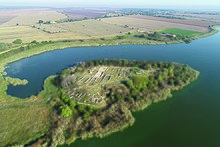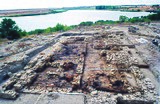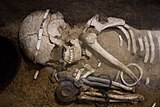306:
generations of house reconstructions. Buildings were rectilinear and large, narrow paths separated individual houses, which stood alone or abutted by other buildings. The structures were robust and made of large wooden posts sunk into foundation trenches and joined with wooden planks or branches covered with mud or clay. In all building horizons, except for in the earliest ones, buildings were internally divided into separate, mainly rectilinear, rooms. Stone structures and bases from the houses are well preserved and there is a cave and some cisterns to see. Durankulak is one of few monuments left from early farming societies in Europe and tell us about daily life. The excavation in
Durankulak took part between 1974 and 1997 when 1204 prehistoric burials were carefully recorded and the remains of 25 houses were found.
353:
320:
57:
50:
34:
344:
332:
305:
was already in general use and became a characteristic phenomenon in the settlement that was unique in Europe. Durankulak lake was a well-organized aggregation of buildings of substantial size with several rooms. They were coherently laid out according to a plan that was repeated over successive
309:
The name is of ancient origin meaning the place where the taurus knocked with his fist (hoof) and gushed water surrounded the two isles in the lake. It is like a legend of the chosen land for ever giving life and prosperity. Golden ornamentations of tauruses were found in
Thracian tombs, Roman
413:
Todorova, H. 2002a. Durankulak, Band II, die prähistorischen gräberfelder von
Durankulak, Teil 1. Berlin-Sofia: Publ. House Anubis. Todorova H. 2002b. Durankulak, Band II, die prähistorischen gräberfelder von Durankulak, Teil 2. Berlin-Sofia: Publ. House
464:
102:
352:
319:
369:
301:. Hamangia people were small-scale cultivators and plant collectors who built houses, made pottery, herded and hunted animals. Around 4700/4600 BC the
49:
444:
449:
459:
454:
424:
293:, dated from the middle of the 6th millennium to the middle of 5th millennium BC, and were the first manifestation of the
286:, Bulgaria. Prehistoric settlement commenced on the small island approximately 7000 BP and lasted for thousands of years.
331:
215:
425:"Varna Chalcolithic Necropolis: Symbolic burials from tombs 36, 2 and 3 | National History Museum"
279:
211:
33:
302:
219:
374:
343:
311:
294:
290:
237:
207:
90:
283:
223:
394:
438:
241:
264:
384:
276:
227:
389:
379:
76:
118:
104:
298:
80:
56:
325:
465:
Populated places established in the 6th millennium BC
260:
252:
247:
233:
203:
195:
187:
179:
174:
166:
158:
150:
142:
96:
86:
72:
265:https://www.dobrichmuseum.bg/durankulashko-ezero/
8:
19:
370:List of ancient cities in Thrace and Dacia
32:
18:
406:
315:
282:on the Golemija ostrov (Big Island) in
7:
358:Burial at the Durankulak necropolis
170:1.5 km (0.58 sq mi)
14:
351:
342:
330:
318:
55:
48:
445:1974 archaeological discoveries
289:The first inhabitants were the
16:Archaeological site in Bulgaria
1:
450:Prehistoric sites in Bulgaria
337:Durankulak, stone foundations
460:Chalcolithic sites of Europe
481:
455:Neolithic sites of Europe
43:
31:
25:
24:
240:(proto civilization),
146:Prehistoric settlement
119:43.66944°N 28.53250°E
64:Shown within Bulgaria
310:burials and in the
280:archaeological site
114: /
21:
303:stone architecture
124:43.66944; 28.53250
270:
269:
191:5th millennium BC
472:
429:
428:
421:
415:
411:
375:Karanovo culture
355:
346:
334:
322:
312:Varna Necropolis
291:Hamangia culture
238:Hamangia culture
138:
137:
135:
134:
133:
131:
126:
125:
120:
115:
112:
111:
110:
107:
91:Dobrich Province
59:
58:
52:
36:
22:
480:
479:
475:
474:
473:
471:
470:
469:
435:
434:
433:
432:
423:
422:
418:
412:
408:
403:
366:
359:
356:
347:
338:
335:
326:
323:
284:Durankulak lake
199:10th century AD
129:
127:
123:
121:
117:
116:
113:
108:
105:
103:
101:
100:
68:
67:
66:
65:
62:
61:
60:
39:
27:
17:
12:
11:
5:
478:
476:
468:
467:
462:
457:
452:
447:
437:
436:
431:
430:
416:
405:
404:
402:
399:
398:
397:
395:Tell Yunatsite
392:
387:
382:
377:
372:
365:
362:
361:
360:
357:
350:
348:
341:
339:
336:
329:
327:
324:
317:
268:
267:
262:
258:
257:
254:
250:
249:
245:
244:
235:
231:
230:
205:
201:
200:
197:
193:
192:
189:
185:
184:
181:
177:
176:
172:
171:
168:
164:
163:
160:
156:
155:
152:
148:
147:
144:
140:
139:
98:
94:
93:
88:
84:
83:
74:
70:
69:
63:
54:
53:
47:
46:
45:
44:
41:
40:
37:
29:
28:
15:
13:
10:
9:
6:
4:
3:
2:
477:
466:
463:
461:
458:
456:
453:
451:
448:
446:
443:
442:
440:
426:
420:
417:
410:
407:
400:
396:
393:
391:
388:
386:
383:
381:
378:
376:
373:
371:
368:
367:
363:
354:
349:
345:
340:
333:
328:
321:
316:
314:
313:
307:
304:
300:
296:
292:
287:
285:
281:
278:
274:
266:
263:
259:
255:
251:
246:
243:
242:Varna culture
239:
236:
232:
229:
225:
221:
217:
213:
209:
206:
202:
198:
194:
190:
186:
182:
178:
173:
169:
165:
161:
157:
153:
149:
145:
141:
136:
99:
95:
92:
89:
85:
82:
78:
75:
71:
51:
42:
35:
30:
23:
419:
409:
308:
288:
272:
271:
212:Chalcolithic
385:Seuthopolis
277:prehistoric
228:Middle Ages
122: /
97:Coordinates
439:Categories
401:References
390:Solnitsata
380:Perperikon
273:Durankulak
248:Site notes
220:Bronze Age
216:Old Europe
130:Durankulak
128: (
109:28°31′57″E
106:43°40′10″N
77:Durankulak
38:Durankulak
26:Дуранкулак
20:Durankulak
295:Neolithic
253:Condition
224:Antiquity
208:Neolithic
196:Abandoned
162:28.532256
154:43.669203
364:See also
299:Dobrudja
297:life in
234:Cultures
180:Material
81:Bulgaria
73:Location
414:Anubis.
261:Website
204:Periods
188:Founded
175:History
151:Length
87:Region
275:is a
256:Ruins
183:Stone
159:Width
167:Area
143:Type
441::
226:,
222:,
218:,
214:,
210:,
79:,
427:.
132:)
Text is available under the Creative Commons Attribution-ShareAlike License. Additional terms may apply.





